A disease like osteochondrosis of the thoracic and cervical spine is now considered a fairly common disease in people of different ages.

A sedentary lifestyle, improper posture and wearing uncomfortable shoes can lead to a rather serious illness that is difficult to diagnose in the early stages.
Features of osteochondrosis of the thoracic spine
Osteochondrosis of the thoracic spine, most commonly referred to as thoracic chondrosis, is a disease of the intervertebral discs of the thoracic spine. Chest degenerative disc disease is also known as "chameleon" because the symptoms are not recognized immediately and can be mistaken for a completely different disease.
Most often the disease occurs due to metabolic disorders and excessive stress on the intervertebral discs. Chondrosis disrupts the normal functioning of the intervertebral disc.
Unlike other types, osteochondrosis of the breast is less pronounced and has the following symptoms:
- Aching pain in the chest,worse at night, with sharp curves or hypothermia.
- Pain between the shoulder bladeswith a sharp rise in the extremity or sharp bends.
- Sharp pain when sighingand tightness in the chest.
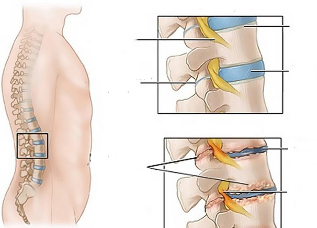
The above symptoms relate to the early stages of the disease.
The following symptoms can occur if the disease continues for a long time without medical intervention:
- Numbness in small areas of the skin.
- Legs itching or burning.
- Severe peeling of the skin.
- Slight pain in the throat or esophagus.
- Poor gastrointestinal function.
Osteochondrosis of the cervical spine
Osteochondrosis of the cervical spine, or cervical chondrosis, is a disease that weakens the intervertebral discs and causes a change in the structure of the intervertebral discs themselves and the neck joints. Nerve endings can become inflamed and compressed by destructive intervertebral discs.
According to the International Classification of Diseases (ICD-10), it has the code M42. 02.
The following pain sensations are inherent in the disease:
- Regular headaches.
- Regular painful pain in the neck, back and shoulders.
- Short-term visual impairment.
- Reduces the sensitivity of the collar zone.
Symptoms of cervical chondrosis
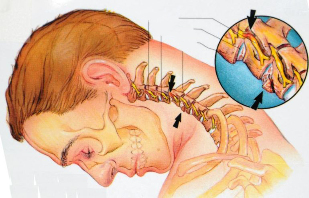
The second degree is characterized by the appearance of small vertebral hernias and the following symptoms:
- Pain in the cervical spine, strong crunching when turning the head sharply.
- Periodic loss of sensation in the arms and shoulders.
- Visual impairment and recurring ringing in the ears, sleep disorders.
- Numbness of the face and neck, weakening of the upper limbs.
- Regular sharp pain in the shoulder blades.
The third stage of cervical osteochondrosis is difficult to treat. The intervertebral hernia increases in size, there is a deformation of the spine.
In the third stage, the following symptoms occur:
- Severe pain in the neck and heart.
- Loss of sensitivity in the scalp, arms and shoulders.
- Paralysis of the upper limbs.
- hernia of the cervical vertebrae.
The fourth stage is characterized by an exacerbation of all of the above symptoms.
Symptoms of cervicothoracic osteochondrosis
A fairly common disease that directly affects the neck and chest region. It can start at absolutely any age due to back injuries, a sedentary lifestyle, and being overweight. An important role play hereditary factors and works in dangerous production (excessive vibration).
According to ICD-10, this type of osteochondrosis has the code M 42. 02.
Symptoms of cervicothoracic osteochondrosis include:
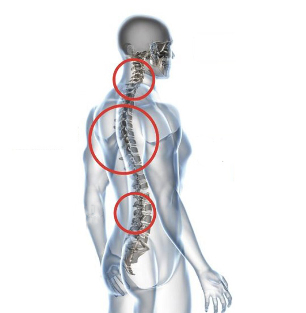
- Sudden dizziness.
- Painful pain in the neck and shoulders.
- Pain in the right hypochondrium.
- Drop in blood pressure and tachycardia.
Osteochondrosis with radicular syndrome
The disease got its name because of the dysfunction in the roots of the intervertebral nerves.
When the roots are affected, a number of rather messy symptoms develop, including sharp "stabbing" pains in the lumbar spine and neck.
The symptoms also include:
- Temporary loss of the ability to move.
- Loss of feeling in the limbs.
- muscle hypotrophy.
- Changes in neurological reflexes (detected on examination by a neurologist).
The following factors are related to the occurrence of radicular syndrome:
- Uneven stress on the spine when you are overweight, pregnant and wearing uncomfortable shoes.
- Asymmetry of the lower limbs, flat feet.
- Injuries, sharp loads on the spine.
If the disease is detected early, no surgical intervention is required.
Causes of cervical osteochondrosis
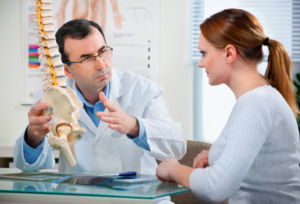
The main reasons for developing osteochondrosis:
- Heavy, sedentary work, sedentary lifestyle.
- Previous spinal injuries and spinal curvature.
- Stress and nervous strain.
- Lack of physical fitness.
- Lack of healthy eating.
Degrees of osteochondrosis of the chest and neck region
The following degrees of disease are characteristic of the development of cervical osteochondrosis:
- For the first stagechanges in the intervertebral discs are characteristic. Changes begin due to the disappearance of fluid reserves from the core of the intervertebral discs. Pain is not yet felt.
- In the second phasethe intervertebral discs become flatter. As a result, the ligaments and muscles are put under heavy strain, which leads to numbness due to the constant heavy load. Constant dizziness is characteristic.
- The third stageis characterized by significant changes in the bone and cartilage tissue, the occurrence of osteoarthritis.
- The fourth stageis characterized by the appearance of bone growth on the vertebrae.
Diagnosis
To diagnose osteochondrosis, a full examination of the spine must first be performed. Signs of early stage osteochondrosis can be confused with a number of other diseases. The diagnosis must be carried out by a highly qualified specialist.
To diagnose the disease, you need to contact the attending physician, who will refer you to a specialist with a narrower profile. The sooner the patient seeks medical help, the faster and safer the treatment will be.
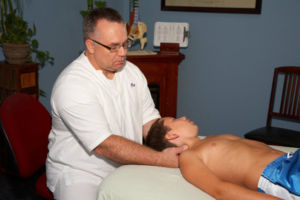
In fact, osteochondrosis is not treated by one specialist, but by several:
- Radiologist.After receiving the X-ray results, the picture of the disease becomes clearer.
- Chiropractor. Determines the exact location and stage of the disease.
- The doctor is an osteopath.The treatment method is very similar to manual therapy.
- Doctor - neuropathologist.Osteochondrosis is closely linked to diseases of the nervous system. The doctor will help treat the disease in both the first and second stages.
- Doctor - Physiotherapist.Is a specialist in physiotherapy exercises. Physical education only helps in the early stages of the disease.
A sharp exacerbation of the disease is considered quite common. In such cases, you should immediately consult a neurologist. Osteochondrosis of both the cervical and thoracic and lumbar regions is closely related to a nerve disease. The neurologist will prescribe a course of taking special drugs for pain relief.
Osteochondrosis during pregnancy and lactation in women
Osteochondrosis during pregnancy is a common phenomenon because during pregnancy a woman goes through a global restructuring and a very large stress on the whole body. A disease of the fetus has no effect, but it can cause a number of serious problems during childbirth.
It is also recommended to have a doctor monitor the breastfeeding period and to wear corrective corsets to reduce tension in the spine.
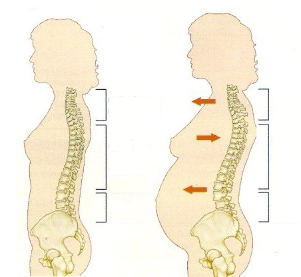
The reasons for osteochondrosis to occur during pregnancy are:
- Weight gain and heavy stress on the spine as well as wearing uncomfortable shoes.
- Pressure of the uterus on neighboring organs.
- Change in hormone levels.
- Lack of useful vitamins and minerals.
- Lack of rest and sleep, various types of stress.
To prevent the disease, you need to consult a doctor at the first disturbing signs. You shouldn't wait for the pregnancy to end. After giving birth, the disease can progress and it will be much more difficult to cure.
If an illness is detected, the pregnant woman must wear a prenatal bandage, a number of vitamins and minerals, and special gymnastics.
First aid for the worsening of osteochondrosis at home
The duration of the exacerbation depends on the type and degree of neglect of the disease. Most often, an exacerbation can last from 1 week to 1 month.
Attention! In the event of an exacerbation of the disease, it is prohibited: warming up in a bath or other warming, massage and self-medication.
If a sudden attack occurs before doctors arrive, you need to do the following:
- Give the patient maximum rest.
- If possible, lay the patient on a firm surface.
- Apply a cool compress to the affected area.
- Apply an anti-inflammatory ointment to the affected area.
If a visit to a specialist is not possible in the near future, you need to take the following measures:
- Take a warm, relaxing shower.
- Do not make any sudden movements.
- Do not lift weights.
- To avoid further entrapment, keep your neck still.
Dorsago and dorsalgia
Dorsagois the name of one of the symptoms of inflammation of the thoracic spine. Dorsago is characterized by severe pain in the heart area, which is most common in people who do monotonous sedentary work or who have been in an uncomfortable position for a long time. Short-term breathing difficulties are possible with sudden movements.
Dorsalgia- pain syndrome that occurs during a sharp exacerbation of the disease and lasts about 2 weeks. With dorsalgia, the pain gradually increases. The pain is especially severe when you bend forward or breathe deeply. The most common traction pain occurs in the shoulder blade area in the lumbar spine area.
Methods for the treatment of cervical and thoracic osteochondrosis
In the event of illness, various methods are used to treat osteochondrosis.
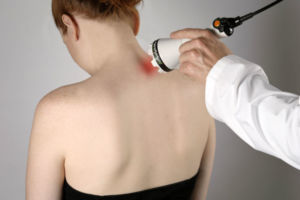
The most common are called:
respected- Physiotherapy- paraffin compresses, magnetic field therapy, laser therapy.
- Physiotherapygymnastics and massage.
- Reflex therapy- The treatment is carried out with needles that act on the affected areas. Before starting treatment, it is necessary to consult a specialist, as there are a number of contraindications.
- Folk remediesand diet.
- Medicines- are only prescribed after a full examination by a specialist.
Medicines
To relieve pain in the spine, doctors usually prescribe medication. When the stage is advanced, medication will relieve the pain for a short time. To relieve pain and further inflammation, doctors prescribe NSAIDs in the form of tablets or capsules.
Chondoprotectors- another type of medication that is prescribed for osteochondrosis. The drugs are designed to protect and strengthen bone and cartilage tissue from destruction.
When there is a strong inflammatory process in muscle tissue, the patient is prescribed drugs to relieve muscle spasms.
The dosage must be determined by the attending physician. Taking medication does not last more than 3 weeks.
Also, one of the effective methods of drug treatment is the use of injections, which can relieve pain.
Fixing agent
In the case of complex treatment, the patient can be prescribed to wear special fixation corsets and bandages.
Exercises for osteochondrosis
Exercises prescribed in a physical therapy room can not only relieve pain, but also strengthen the muscles of the spine, which further prevents the development of various complications. And posture improves significantly even after several physical therapy exercises.
Well-known doctor Bubnovsky has developed a series of exercises for the treatment of osteochondrosis that can be used at home.
The most common exercises are:
- Walking, gently lifting arms and legs.
- Rotation of the shoulders in different directions, bringing and stretching the shoulder blades.
- Slow head leans to one side.
- Stretching exercises for the muscles of the spine and neck.
- flexion of the arms and legs.
With cervical osteochondrosis, it is forbidden to turn your head, as this can lead to a complication of the disease.
Physiotherapy treatments
Physiotherapy is mainly aimed at relieving pain in the spine. The procedure improves blood circulation, oxygenates the muscles.
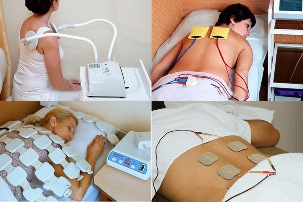
Nowadays the most common physiotherapy procedures are:
- Massage with vibration- helps to get rid of pinched nerves in the intervertebral discs. Contraindication - pregnancy, high blood pressure.
- Acupuncture- relieves pain. It also helps relax your back muscles. A contraindication is epilepsy.
- Electrotherapy- The method consists in using a weak current effect on the affected areas of the spine. A contraindication is the presence of heart disease.
- Ultraviolet- enriches the body with vitamin D, which means that calcium is absorbed more quickly. It also has anti-inflammatory effects on the affected area. Contraindication to the procedure is the presence of blood diseases, allergic reactions on the skin, cancer.
Treatment of osteochondrosis with folk remedies
In the complex treatment of the disease, some doctors also recommend the use of folk remedies to get rid of the disease. In complex treatments, it is especially important to use the correct dosage and treatment method.
Folk remedies for home use relieve pain in the area of muscles and joints and also restore the mobility of the joints: This technique is widely used in treating the disease. Valentin Ivanovich Dikul first tested his method on himself. Dikul's technique is indicated for diseases of the spine and intervertebral hernias. The following principles should be observed during training: For complex treatments, a special diet must be followed, which includes: The diet assumes one exception: To prevent the development of the disease or to stop its development, the following prophylaxis must be used: With proper compliance with all of the above recommendations and with timely referral to specialists, almost any disease can be cured. Treatment for osteochondrosis costs much more time and money, but advanced disease can result in a wheelchair.Method for the treatment of osteochondrosis according to Valentin Dikul
Nutritional principles for osteochondrosis

Preventive measures
Conclusion





































